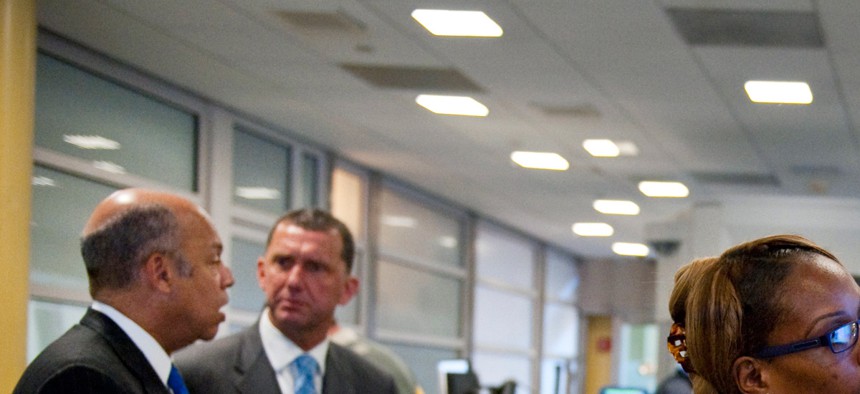
Secretary of Homeland Security Jeh Johnson visits with Transportation Security Administration employees during his visit to Ronald Reagan Washington National Airport on Nov. 24, 2014. Official DHS photo by Barry Bahler
What a Homeland Security Shutdown Would Look Like
If the new Congress can't cut a deal with the president on Department of Homeland Security funding, here's what could happen come March. By Rachel Roubein
After President Obama's executive order deferring deportation for millions of undocumented immigrants, Republicans crafted a counterattack, one they hoped would eventually force Obama to the bargaining table: a spending package that would fund the Homeland Security Department through only Feb. 27.
Now Republicans are back. They're ready for action on immigration, and the House could move to fund DHS by the end of January. But if political wrangling ultimately supersedes deal-making, and Congress can't cut a deal with Obama, here's what could happen come March.
It's likely that the majority of DHS employees would still go to work. And the main agency tasked with overseeing the program in question, U.S. Citizenship and Immigration Services, is funded through fees rather than appropriations legislation.
It's not clear that GOP leaders will have much leverage. Aside from the potential political fallout if the department runs out of cash, it turns out that a DHS "shutdown" might be one in name only, and Obama's executive order might well proceed as planned.
(Related: The US-Cuba Turnaround Just Raised the Stakes for Border Security)
Yet, budget confidence is "absolutely essential" to smoothly and effectively running an agency, said Stan Soloway, president and CEO of the Professional Services Council. The political optics, he said, let alone the real implications, of a shutdown are generally to be avoided—and this will likely create shutdown resistance within both parties. But that doesn't mean the option is completely off the table.
"I think a lot of us were really surprised that it got to a shutdown [in 2013]," Soloway said. "It's really difficult to predict how this will play out."
But it's a bit easier to predict what a shutdown would look like for DHS. During the October 2013 shutdown, nearly 200,000 of DHS's 231,000-plus civilian and military employees were likely exempted from emergency furloughs. That means more than 85 percent of DHS workers continued doing their jobs, according to a Congressional Research Service report on DHS's funding lapse.
There are two main types of employees who still work: those whose jobs are paid for by fees and multiyear appropriations, and those who save lives or protect property.
U.S. Citizenship and Immigration Services is busy readying the rules and guidelines for Obama's unilateral action, which provides work permits and deportation deferrals to millions of undocumented immigrants. But the agency is fee-funded, meaning that it doesn't need annual appropriations to continue operating. And during the most recent shutdown, about 97 percent of its employees were instructed to keep working, according to the department's September 2013 report, "Procedures Relating to a Federal Funding Hiatus."
Those life- and property-saving functions include border-security programs and immigration enforcement and removal operations. They include air-passenger screening, maritime security, Secret Service protection, and more.
But while many employees worked during that shutdown, several of the department's operations were curtailed. These included non-disaster grant programs as well as law-enforcement, civil-rights, and civil-liberties training, and more, according to the Congressional Research Service report.
The staffing impacts of a shutdown are easy to measure, but staffing doesn't necessarily show the full picture. The government eases its contracting activities. Employee hiring, research efforts, and other projects can be stalled. And most employees go unpaid until the government is funded, the report states.
While the DHS funding feud continues, short-term funding deals—called continuing resolutions—create a chaotic and uncertain environment, hurting the department even before funding can expire, Soloway says.
"Any time you don't have a clear path of funding, you have to be careful," he said, "because you can't get out over your skis, you can't outspend what appropriations you have."
DHS comprises at least 16 agencies and offices, including the Coast Guard, Customs and Border Protection, the Federal Emergency Management Agency, and the Secret Service. At a December House hearing, DHS Secretary Jeh Johnson detailed the possible effects of funding DHS for only a few months.
"During that period of a CR, we cannot engage in new starts," Johnson told the House Homeland Security Committee. "We've got some Homeland Security priorities that need to be funded now."
For example, a presidential-election cycle is starting, but DHS can't hire more Secret Service agents. Funding for enhanced detention capabilities in Texas will be hindered, Johnson told the committee—at least until the department is funded through fiscal 2015.
(Read More: Are We Downplaying the Risks of Homegrown Terrorism?)
Additionally, investing in new border surveillance would be put on hold. DHS's non-disaster grants, which go to state and local municipalities, will go unfunded. And the budget uncertainty could potentially delay the delivery of a National Security Cutter, which is the centerpiece of the Coast Guard's fleet, according to a DHS official.
Immigration isn't the department's only function, and withholding the purse strings puts DHS in a difficult position, Tom Ridge, a former Homeland Security secretary, told National Journal.
"I would be very, very disappointed if I were secretary, and the Democrats did it to me," said Ridge, also a former Republican Pennsylvania governor.
"It's pretty difficult to plan long term when you don't exactly know how much you're going to have available and what strings might be tied to it," he added. "My hope is that my Republican friends feel you made your point, get it out as soon as you get back. Give them the funding they need."




